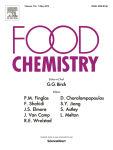Ver ítem
- xmlui.general.dspace_homeCentros Regionales y EEAsCentro Regional Mendoza - San JuanEEA MendozaArtículos científicosxmlui.ArtifactBrowser.ItemViewer.trail
- Inicio
- Centros Regionales y EEAs
- Centro Regional Mendoza - San Juan
- EEA Mendoza
- Artículos científicos
- Ver ítem
Evaluation of dihydroquercetin-3-O-glucoside from Malbec grapes as copigment of malvidin-3-O-glucoside
Resumen
Malbec is a wine grape variety of great phenolic potential characterized for its high levels of anthocyanins and dihydroflavonols. To evaluate the possible implication of dihydroflavonols in the expression of red wine color through reactions of copigmentation or condensation, assays were carried out in wine model systems with different malvidin-3-O-glucoside:dihydroquercetin-3-O-glucoside molar ratios. The addition of increasing levels of
[ver mas...]
Malbec is a wine grape variety of great phenolic potential characterized for its high levels of anthocyanins and dihydroflavonols. To evaluate the possible implication of dihydroflavonols in the expression of red wine color through reactions of copigmentation or condensation, assays were carried out in wine model systems with different malvidin-3-O-glucoside:dihydroquercetin-3-O-glucoside molar ratios. The addition of increasing levels of dihydroquercetin-3-O-glucoside to a constant malvidin-3-O-glucoside concentration resulted in a hyperchromic effect associated with a darkening of the anthocyanin solutions, greater quantity of color and visual saturation, perceptible to the human eye. Copigmentation and thermodynamic measurements showed that dihydroquercetin-3-O-glucoside can act as an anthocyanin copigment, similar to other usual wine components like flavanols or phenolic acids, although apparently less efficient than flavonols. The high levels of dihydroflavonols existing in Malbec wines in relation to other non-anthocyanin phenolics should make this family of compounds particularly important to explain the color expression in Malbec young red wines.
[Cerrar]

Autor
Fanzone, Martín Leandro;
González-Manzano, Susana;
Pérez-Alonso, Joaquín;
Escribano-Bailón, María Teresa;
Jofre, Viviana Patricia;
Assof, Mariela Vanesa;
Santos-Buelga, Celestino;
Fuente
Food Chemistry 175 : 166-173 (May 2015)
Fecha
2015-05-15
ISSN
0308-8146
Formato
pdf
Tipo de documento
artículo
Palabras Claves
Derechos de acceso
Restringido
 Excepto donde se diga explicitamente, este item se publica bajo la siguiente descripción: Creative Commons Attribution-NonCommercial-ShareAlike 2.5 Unported (CC BY-NC-SA 2.5)
Excepto donde se diga explicitamente, este item se publica bajo la siguiente descripción: Creative Commons Attribution-NonCommercial-ShareAlike 2.5 Unported (CC BY-NC-SA 2.5)

